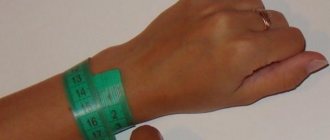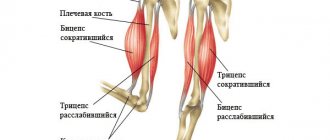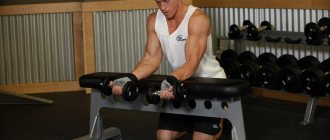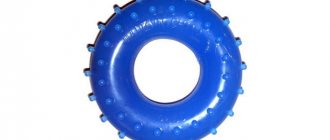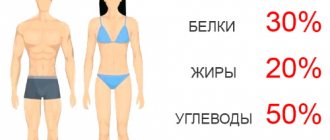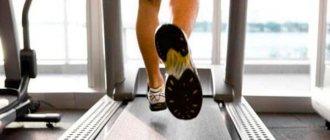Therapeutic gymnastics for hands
The hands are a rather fragile structure in the human body, and at the slightest careless or awkward movement of the joints, we immediately feel unpleasant pain in this area: all the microtraumas we receive, even the most minor ones, lead to pain in the hands. However, pain in the hands is not always associated with previous injuries. In this set of exercises, we will tell you what to do if your hands hurt.
- Interlock your fingers in front of you and perform 10 clockwise wrist rotations. Repeat 10 times counterclockwise. This will increase the flexibility of your hands and wrists while warming up your muscles.
- Straighten your fingers and spread them apart until you feel tension. Hold for 10 seconds and relax. Then bend your fingers at the joints and hold for 10 seconds. Relax.
- With your arms extended in front of you, arch your hands with your fingers upward. This will stretch the muscles on the front of your forearms. Hold for 10-12 seconds. Repeat twice. Then curl your hands downwards to stretch the muscles on the back of your forearms. Hold for 10-12 seconds. Repeat twice.
- Extend your arms in front of you. Then slowly move your hands out to the sides (without bending your arms) until you feel a stretch in the muscles on the inside of your forearms and wrists. Hold for 5-10 seconds. 5. Place your palms in front of you, finger over finger. Then lower your hands down, palms facing away from you. Next, arms forward, palms away from you. After this, arms up, palms away from you. Hold for 5-8 seconds.
- Go to the wall, lean your elbows completely on the wall, arms straight, tilting your body forward. Now, with the help of your hands, push yourself away from the wall, while keeping your fingers on the wall.
- Sitting on a chair, hands on your knees, palms up. So that the hands hang from the knees. Take a small weight (dumbbells) and hold it in your palms. Without taking your hands off your legs, lift the weights (dumbbells) towards you. Repeat 12 times, 3 sets.
- Sitting on a chair, hands on your knees, palms down, so that your palms hang down. Take a small weight (dumbbells, ball) and hold it in your palms. Without taking your hands off your feet, lift the weight as high as possible and lower it. Repeat 12 times for 3 trips.
- Take in your hand and hold a weight (dumbbells, ball) in front of you. Use your free hand to hold your working hand at the wrist. Perform 10 clockwise circular movements and 10 counterclockwise circular movements on each hand. Maximum amplitude. If desired, the weight of the weighting material can be increased.
Why do you need to do hand exercises?
People with an ectomorphic body type often notice that their thin wrists look disproportionate compared to the well-developed muscles of the arms and shoulders, and “how to pump up your wrist?” is the first question they ask the instructor at the gym. This picture is due to the thin radius and narrow wrist joint; many ectomorphs have a wrist volume that does not exceed 12 cm. In this regard, they wonder how to pump up the muscles of the hand and how noticeable the result will be.
The musculature of the hand consists of 33 small muscles that are responsible for pronation and supination of our palms, as well as grip strength. Therefore, if you are wondering how to improve your grip, be sure to find a place in your training process for static exercises for the hands. It won’t take much time: it’s enough to spend 15-20 minutes working on such small muscle groups at the end of a regular workout in the gym.
© mikiradic — stock.adobe.com
A well-developed grip makes it easier to perform back exercises without the use of wrist straps or hooks, and is also necessary for really serious deadlifts. It is also necessary for victories in arm wrestling and martial arts, because truly strong arms begin with strong hands.
In addition, exercises for the hands and palms should be done by people who have suffered arm injuries; this will restore their former strength and mobility. Many of the exercises listed in our article are recommended by experienced doctors as part of recovery from injuries.
Contraindications to the use of exercises
There are no special contraindications to performing physical therapy. However, there are some restrictions on the use of gymnastics for hands and fingers for arthritis:
- Why is finger exercises necessary for arthrosis of the hands?
- relapses accompanied by an acute form of inflammation;
- increased body temperature;
- sudden changes in pressure;
- vascular diseases, pathologies of the heart, lungs and kidneys;
- respiratory failure;
- oncological diseases;
- acute infections.
Stretching exercises
Stretch on the floor
Sit on the floor on your feet, place your palms in front of you, fingers facing you. Move your body back, increasing the angle at your wrist. Hold at the extreme point for 3-5 seconds, come back and repeat. Perform 5–10 times.
Fist Stretching
Sit on the floor on your feet, place your hands in front of you with the backs on the floor, fingers facing each other. Keep your elbows straight and transfer some of your weight to your arms to better stretch the muscles. From this position, pull your fingers towards the middle of your palm, trying to clench your fists. Repeat the exercise eight times, rest a little and do three more approaches.
Perform these exercises 1-2 times a week to quickly strengthen your wrists, increase your grip strength, and protect yourself from injury.
Functional motor test
To determine which set of exercises is suitable for a patient with arthritis of the hands and fingers, the doctor conducts special functional motor tests. The specialist observes how the patient performs the actions assigned to him and calculates points for their implementation. The final assessment allows us to determine whether the patient has limitations of a functional-motor nature and is able to independently care for himself and perform work.
The results of the test determine which method of exercise therapy will be most appropriate for a particular person.
Self-medication for arthritis is strictly prohibited. This also applies to physical therapy. A course of therapeutic and preventive gymnastics is prescribed by a rheumatologist or physiotherapist.
Physical therapy is a simple and effective way to prevent and treat arthritis. Thanks to a set of simple workouts, you can get rid of stiffness in movements, pain and improve the motor function of your hands. Gymnastics will help you forget about the discomfort that arthritis has brought into your life.
Sources: https://pikabu.ru/story/gimnastika_pri_artrite_paltsev_ruk_5049556 https://zen.yandex.ru/media/systavi/10-effektivnyh-uprajnenii-dlia-palcev-ruk-pri-artroze https://www.3vozrast.ru/ article/health/svedenia/13290/https://econet.ru/articles/135979-10-prostyh-uprazhneniy-dlya-kistey-ruk-pri-artrozehttps://www.liveinternet.ru/users/3347825/post309948931https: //ostamed.ru/bolezni/artrit/gimnastika-dlya-paltsev-ruk-pri-artrite.html
Anatomical features
The basis of our arms is the biceps and triceps when it comes to the muscles themselves. It is these muscles that are responsible for the shape of the limbs and require special loads. After all, in ordinary life they work quite little. Because of this, they become soft, flabby, even jelly-like to the touch. This state of affairs is typical for both men and women.
But all these imperfections are not a death sentence. It is quite possible to eliminate them with the help of a set of effective exercises that allow you to build muscle mass and create aesthetic relief. In the process of regular training, muscles (biceps and triceps) become more elastic and increase in volume. Alternatively, on the contrary, they decrease when the goal of the training is to lose extra pounds.
Exercises for the arm muscles of the video allow you to bring both too thick limbs and too thin ones into the desired shape. And special attention is paid here to strength training.
In this case, it is important to remember that the main load during exercise falls on the shoulder joint. To avoid injury, you must strictly follow the technique of performing the movements and do not try to work with heavy weights from the very beginning. You can learn how to work your biceps and triceps correctly from the video below.
Some exercises for arthritis of the fingers
Clenching - unclenching a fist. This is a very simple exercise and is usually recommended to start with. Touching fingers. The tip of the thumb touches all the other fingers in turn. Spreading fingers. Place your hands on the table, spread and connect your fingers. Perform as forcefully as possible. Finger lifting. Hands on the table, raise and lower each finger in turn. Rotate with fingers. This exercise is similar to the previous one, but we not only raise our fingers, but also rotate them either clockwise or counterclockwise. Claws. We bend and straighten the nail and middle phalanges of the fingers.
Warm-up for hands
Warm-up exercises for the hands play an important role in the overall training process. The overall effectiveness of training depends on the quality of their implementation. Before the main complex, you need to “warm up” well: hold your hands in hot water or do a light massage. If you skip this stage, after training you will experience severe pain in your muscles and joints.
- Clench your fists and make several circular movements.
- Place the hand clenched into a fist on the table. Take one finger out of your fist at a time. Make sure to keep the other fingers still during this process.
- Spread your straightened arms to the sides. Make several circular movements with your wrists in one direction and then in the other direction.
- Do wrist curls for 1 minute with each arm.
The time to perform the warm-up depends on the person’s level of preparedness. Most often it takes about 8-10 minutes.
Gymnastics - a means to prevent arthritis
For arthritis of the finger joints, special exercises should be performed repeatedly. This does not require special conditions, you can perform them even outside the home, the required number of repetitions is up to 9 times daily, which is quite doable for any person. Thanks to active gymnastic exercises, blood circulation improves and inflammatory activity decreases. The fluid accumulated in the periarticular tissues and cavities begins to dissolve, swelling and redness subsides. Gymnastics for arthritis of the hands helps to increase muscle tone . Motor ability in the joints improves, and hand motor skills are gradually restored. If all recommendations are followed, the patient’s general condition improves significantly. Basic rules of health-improving exercises for arthritis:
- systematic and regular implementation of classes;
- perform exercises during an exacerbation of the disease;
- train both hands at the same time;
- monitor free breathing and pace.
Special gymnastics for arthritis consists of simple movements that must be performed in such a way as not to experience discomfort. Many people often develop the disease on one finger of one hand. This may be the beginning of the development of disease in all joints of the hand. In any case, exercises should be performed on both hands. Before starting the exercises, you should consult with your doctor, he will recommend the set of exercises that you need. As a rule, gymnastics for the hands is easy to perform; each exercise should be done an average of 8 times, it all depends on the severity of the disease and general well-being. At first it will be a little difficult to perform individual movements, but gradually the joints will become stronger, the time of exercises and their quality will increase.
General training recommendations
To make your hands strong and beautiful, you should follow a number of simple recommendations:
- First of all, don’t forget to give your muscles rest. You don't have to work hard every day. It is enough to load the arm muscles once every 4-5 days.
- Don't skip workouts. Regularity is the key to success.
- During classes, do not be distracted, listen to your own feelings, stick to the execution technique.
- Don't ignore the basic movements. They improve the general condition of the body and keep it in good shape.
- When drawing up a training plan, place more emphasis not on the biceps, but on the triceps. This muscle is larger, which means it needs more intensive training. But we can’t completely forget about the two-headed one either. Try to find a balance.
- When planning to pump up your arm muscles, remember that you won’t be able to do this separately from the rest of your body. Training must be comprehensive.
With the help of a clear example, it is possible to understand the technique much faster, which means that the desired result will not be long in coming. Be sure to watch the video with useful tips from the trainer.
Compressive force training
The compressive force of the hand is clearly visible when shaking hands. An “iron” handshake indicates excellent compressive force. To develop this strength, exercises performed with an expander are effective. You can also use special rubber rings.
Begin classes with an expander or rubber ring, with the help of which no more than 10 compressions are done in one approach. More rigid devices are used a month after constant training.
Other exercises that develop compressive force include chopping wood. Residents of high-rise buildings can replace it by lifting a broom with their fingertips.
